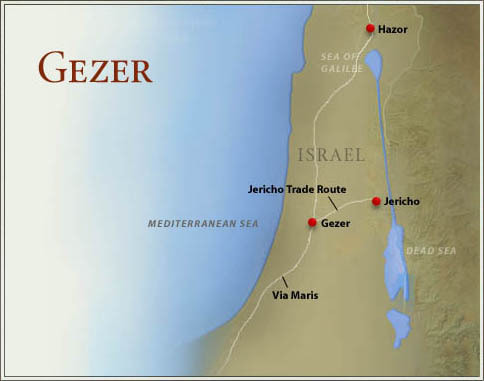|
Gezer, or Tel Gezer, was a city in the foothills of the Judean mountains, approximately midway between Jerusalem and Tel Aviv. Today, the ruins of the city are listed as a national park, however, in the Bible, it was mostly associated with King Solomon.
In the Book of Joshua, Gezer is listed as one of the 48 Levitical cities. Previously, Joshua had defeated the king of Gezer but the Canaanite people were still allowed to live there: “They did not dislodge the Canaanites living in Gezer; to this day the Canaanites live among the people of Ephraim but are required to do forced labour.” (Joshua 16:10) In Joshua 21, the city of Gezer as well as Shechem, Kibzaim and Beth Horon were given to the Kohathite clans of the Levites. Being approximately thirty kilometres northwest of Jerusalem and on the junction of the Via Maris, Gezer would have been an important city on the ancient trade route. The location of Gezer has been easy for archaeologists to find due to inscriptions in both Hebrew and Aramaic on rocks in the area. The inscriptions read “boundary of Gezer” and have been dated to the 1stcentury BC. Large caves in the area, however, suggest the land had been inhabited since the 4thmillennium BC. These people would have lived in the caves but by the early Bronze Age, they had built more substantial dwellings. This, however, was destroyed some time in the 3rdmillennium BC and was abandoned for a few centuries. By 1600 BC, the Canaanites were living in Gezer and had constructed a fortified wall with towers to protect the city. The oldest mention of the city can be found in inscriptions about the Egyptian pharaoh Thutmose III who ruled between 1479 and 1425. During his campaign, a fire destroyed the city of Gezer and the city was rebuilt. Walls four metres in thickness surrounded the new city, which included a palace. Gezer is mentioned in the First Book of Chronicles as the end of the path King David took when slaying the Philistine army. “So David did as God commanded him, and they struck down the Philistine army, all the way from Gibeon to Gezer.” (1 Chronicles 14:16) Later, “war broke out with the Philistines, at Gezer,” (20:4) which sparked a few battles, all of which David and his army won. It is around the 10thcentury BC that King Solomon became involved with the city of Gezer. Known as the “Sack of Gezer” an unnamed Egyptian pharaoh “had attacked and captured Gezer. He had set it on fire. He killed its Canaanite inhabitants and then gave it as a wedding gift to his daughter, Solomon’s wife.” (1 Kings 9:16) After this, Solomon rebuilt the city but there is no Biblical record about the future of Gezer. Due to the ambiguity of dates, it is not possible to determine which Egyptian king ruled concurrently with David and Solomon. Some suggest it may have been Shoshenq I, who ruled from 943 to 922 BC, however, others put forward Siamun (986-967 BC). Since no evidence of either of these suggestions has come to light, the unnamed Egyptian pharaoh remains anonymous. The Assyrians may have captured Gezer in the 8thcentury BC and by the Hellenistic Period (323-31 BC) the city was inhabited by the Maccabees and led by the Hasmonean dynasty. During Roman rule, the population of Gezer dwindled considerably and it is not certain when it was abandoned altogether. During the Crusades, the land surrounding Gezer was used for the site of the 1177 Battle of Montgisard, during which the forces of the Muslim leader Saladin were defeated. Since the early 1900s, Gezer has become one of the most excavated sites in Israel. Amongst the items found on the site are skeletons of people killed in the 13thcentury BC and amulets bearing the royal monikers of Thutmose III and Ramses II (reigned 1279-1213). Many stones bearing inscriptions have also been discovered, such as the boundary stones mentioned above. The most fascinating discovery has been the “Gezer calendar”. This is a small limestone tablet written in either Phoenician or paleo-Hebrew script that describes the monthly periods of the year, including harvest, planting and tending crops. The tablet could have been the work of Abijah, the son of Rehoboam who is mentioned in 1 Kings 14:31. Despite looking rather desolate, Tel Gezer Nature Reserve is free to visit and can be particularly beautiful during the spring when the poppies and lilacs are in full bloom.
0 Comments
Your comment will be posted after it is approved.
Leave a Reply. |
©Copyright
We are happy for you to use any material found here, however, please acknowledge the source: www.gantshillurc.co.uk AuthorRev'd Martin Wheadon Archives
June 2024
Categories
All
|

 RSS Feed
RSS Feed